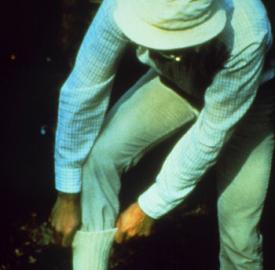Personal Prevention

Personal Prevention Tips for Lyme Disease
Reduce Your Chances Of A Tick Bite
- Avoid tick-infested areas, such as leaf litter under trees. Avoid brushing against long grasses and brush on edges of paths. Don’t sit on stumps or fallen logs.
- Wear light-colored long pants and long sleeves so you can easily see any ticks.
- Tuck shirt into pants and tuck pants into socks.
- Use DEET on skin and treat clothing with spray containing permethrin.
- Do a thorough tick check upon returning inside and for several days following exposure.
- Check bedding for several days following exposure for ticks that drop off.
- Ticks, especially nymphal ticks, are tiny. Find and remove them before they bite.
What To Do If You Are Bitten
- Use fine-point tweezers or a special tick-removing tool. Grasp the tick as close to the skin as possible. If you don’t have tweezers, protect your fingers with a tissue.
- Pull the tick straight out with steady, even pressure. Click here to view a Tick’s Mouth and why it is so important to pull out the tick correctly.
- Avoid squeezing the tick, breaking it, or allowing any blood to remain on your skin.
- Place the tick in a small plastic bag or vial with blades of grass, leaf, or moist (not wet) piece of tissue.
- Label the bag with your name, date, site of bite and how long tick was attached.
- Have the tick identified and tested by a lab, health department or veterinarian.
- Wash your hands, disinfect the tweezers and bite site.
- Educate yourself about tick-borne diseases and consult a doctor to see if treatment is warranted.
Considerations For Prophylactic (Preventive) Treatment
- The tick infection rate in the area where you acquired the tick. An area may still labeled as "no risk" despite lack of scientific studies.
- The relative risk of transmission, depending on whether the tick was a nymph or adult, duration of attachment and how it was removed.
- Whether the tick tested positive for a tick-borne infection.
- The Lyme germs may spread widely in the body, including to the brain, within hours/days.
- The cost of prophylactic treatment vs. risk of infection.
- The risks and benefits of prophylactic treatment vs. risks of infection.






















We invite you to comment on our Facebook page.
Visit LymeDisease.org Facebook Page